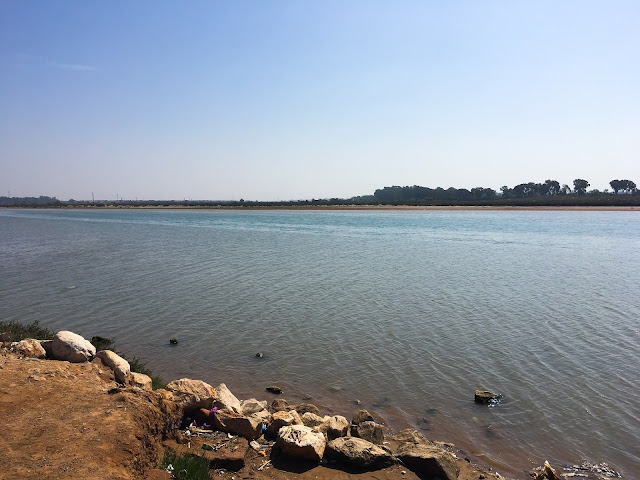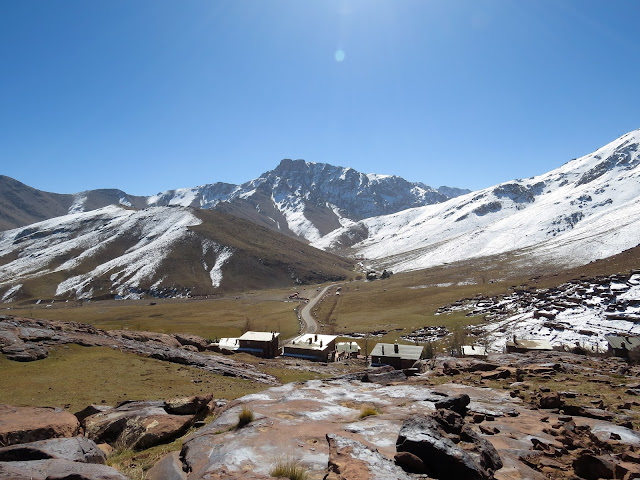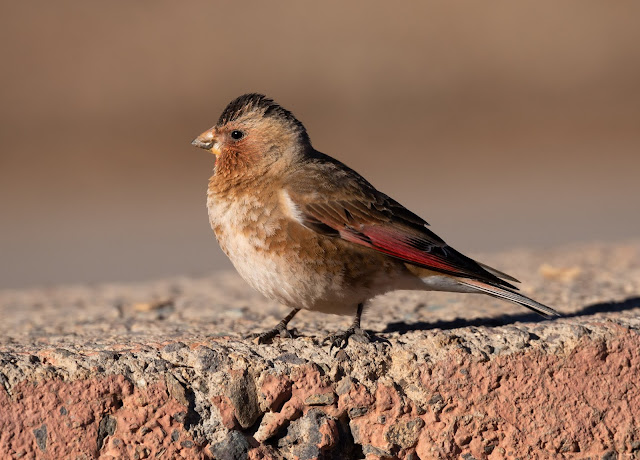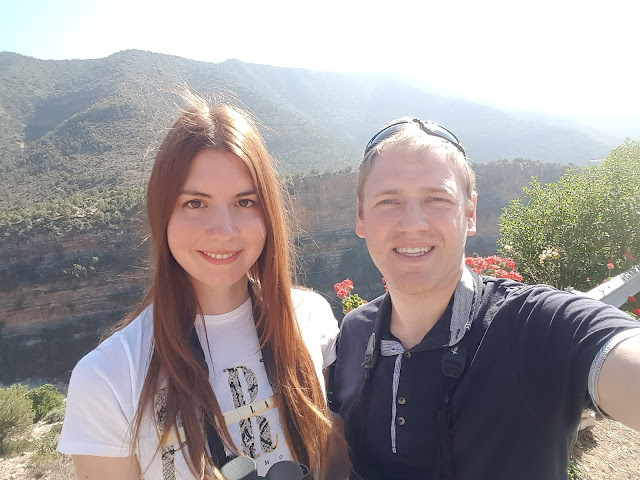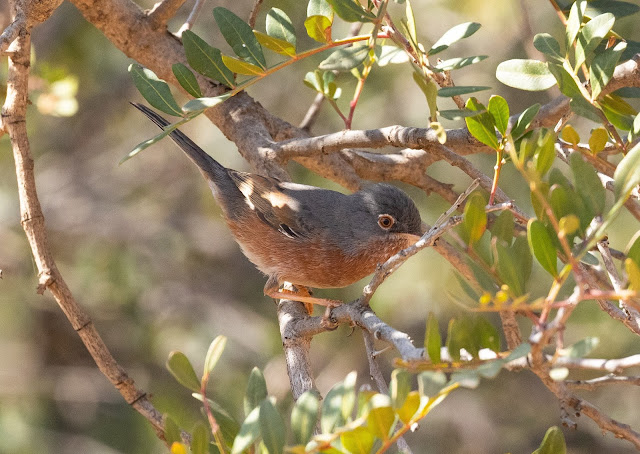Awaking bright and early and taking a punt on
some info we’d found online for Fulvous Babbler, we headed east towards the
town of Taroudant, an hour or so away from Agadir. With scattered Babbler
records in the area dating back a few years, whilst not nailed on we felt it
was at least worth a shot, and sure enough, upon arrival in this unlikely
location the habitat looked ideal, with numerous shrubs and bushes on the
parched ground – perfect for Babblers!
 |
| Prime Babbler habitat at Taroudant aerodrome |
After parking up at the side of the
compound fence at the aerodrome, almost immediately Alex remarkably locked on
to a Fulvous Babbler, perched on one of the prominent branches and providing good but distant views
from in-between the chain-link fence.
 |
| Fulvous Babblers |
As with other Babbler species, Fulvous Babblers
form social groupings, and we eventually counted seven emerging from inside the
shrub and foraging in the sand, moving as a flock from bush to bush.
Flying in to the gatepost trees beside us sadly
saw us too slow with our cameras to get any meaningful shots, and the Babblers
eventually melted in to the foliage and away.
A quick scan of the track around the compound
resulted in an abundance of House Sparrows with a scattering of Spanish Sparrows
thrown in for good measure, while a small flock of Common Bulbuls posed
obligingly by the side of the road. Subalpine and Sardinian Warblers busying
themselves in the low down gorse unfortunately didn’t contain a Tristram’s
amongst them, but a duo of Maghreb Magpies put on a good display as they hopped
amongst a pile of abandoned oranges.
 |
| Common Bulbul |
 |
| Maghreb Magpie |
With nothing more of note around Taroudant apart
from a Thekla Lark, we headed back out of town and north towards
Paradise Valley, stopping to admire the swarms of Pallid Swifts screeching excitedly
along the city walls.
 |
| Thekla Lark |
With Vallée
d'Imouzzer at the top of Paradise Valley holding ad-hoc records of Tristram’s Warbler
during the winter and buoyed on by our Fulvous Babbler success, we decided to
give it a go, the incredible scenery at least a bonus even if the warblers
didn’t show.
Climbing the twisting mountain roads resulted
in an abundance of Moussier’s Redstarts en-route (not quite as showy or
photogenic as our Souss Massa superstar), while healthy numbers of Sardinian
Warblers busied themselves in the spiny shrubbery.
 |
| The beautiful scenery of Paradise Valley |
Stopping off at the first
main car park on our ascent, a quick scout around unearthed yet more Sardinian
Warblers, before remarkably I picked up a male Tristram’s Warbler belting out
its full song above us on the slope. Calling Alex over, we watched as it flew
from bush to bush, getting ever closer, before it eventually landed in the tree
in front of us, eyeing us inquisitively before retreating up the mountainside.
 |
| Tristram's Warbler |
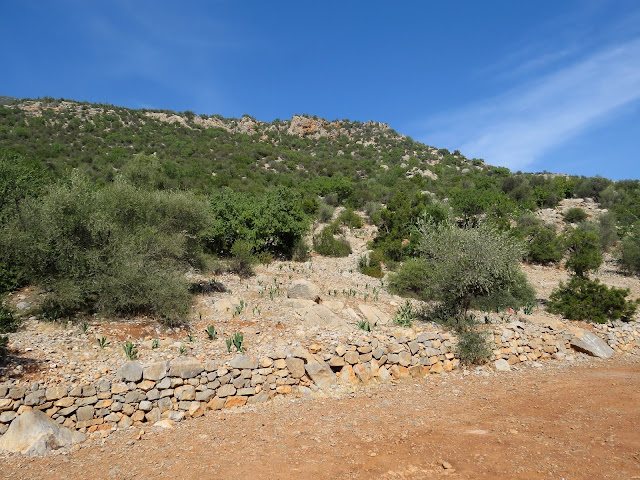 |
| The slope in the car park the Tristram's Warbler was favouring |
With only a smattering of records in this area
during the winter months, this male clearly appeared to be on territory –
begging the question of whether Tristram’s Warblers are in fact breeding here.
A highly range restricted species in North
Africa, being found mainly in Morocco and Tunisia, it was great to catch up
with this star bird, and we enjoyed further views on our descent back down the
valley when we passed the car park again later that afternoon.
 |
| The car park in question |
Once at the top of the valley, a pair of Black
Wheatear provided a nice show against the fabulous backdrop of the gorge below,
while a pair of Bonelli’s Eagles powering down the ridges were our first
of the trip. Having already scored on the Tristram’s Warbler front, we never
actually made it as far as Vallée d'Imouzzer, instead drinking in the views
before making out descent.
 |
| Bonelli's Eagle - note the white patch on the back |
 |
| The views were stunning! |
With time remaining before darkness set in, we
tested out Oued Sous in an attempt to see if the Red-necked Nightjars were
still present. Sadly there was neither sight nor sound of them as the darkness
enveloped the car around us, a lone Zitting Cisticola calling before roost all
we had for company avian-wise amongst the many bikers and fishermen settling in
the car park.
 |
| Zitting Cisticola |
 |
| Suitable habitat for Nightjars at Oued Sous? |
Previously a hotspot to see the nightjars, sadly access
restrictions by the palace now mean the area the nightjars favoured is no
longer accessible, and we headed back to the hotel empty handed, a final dinner
of lamb cutlets fueling us for our concluding day ahead.



